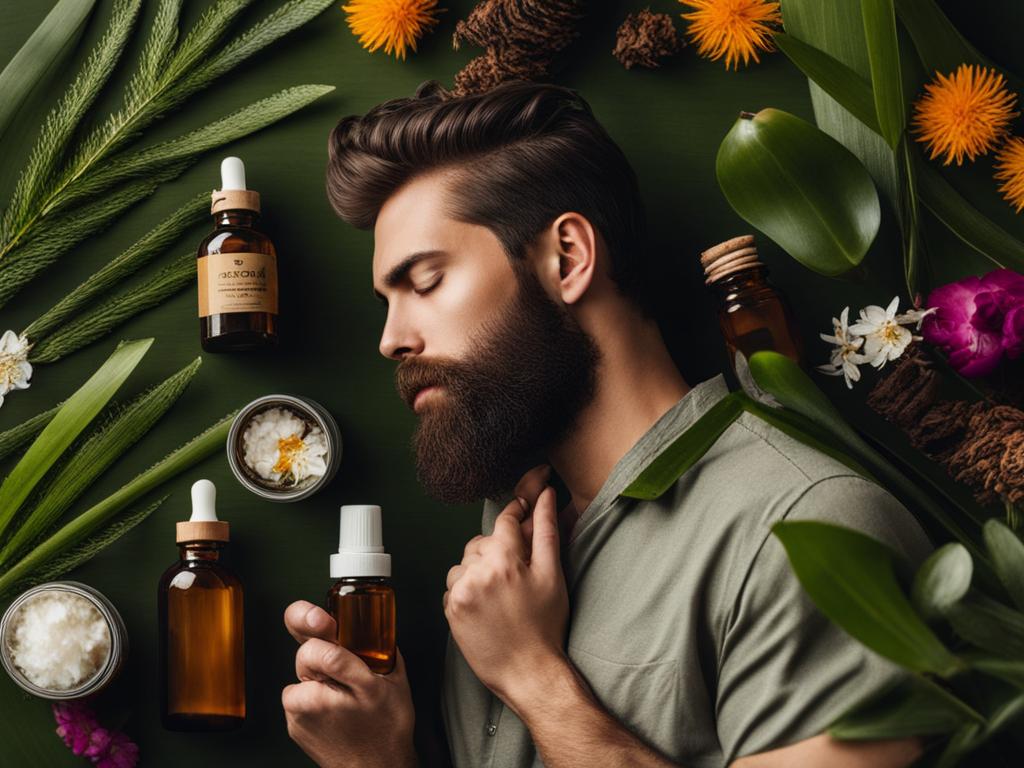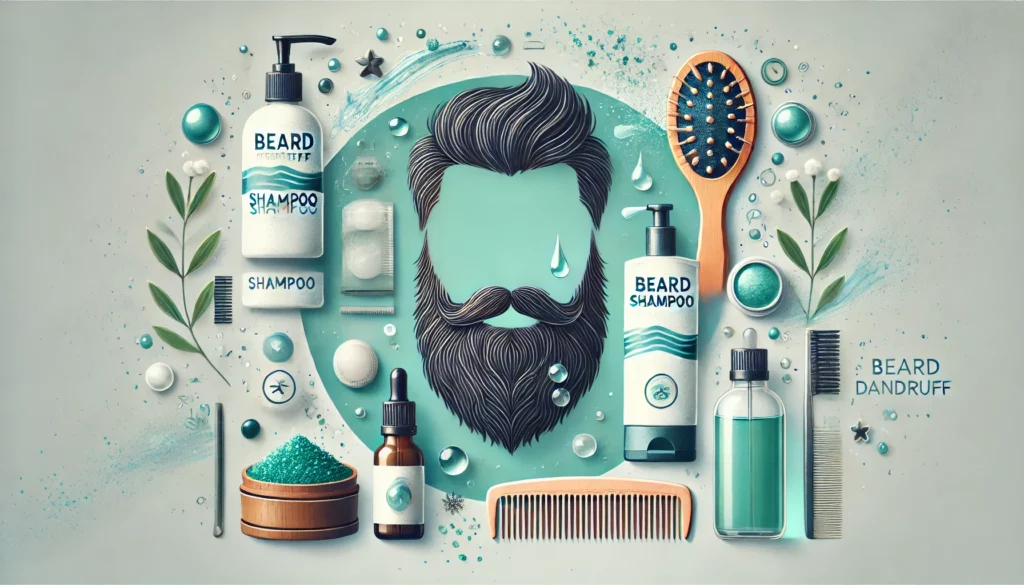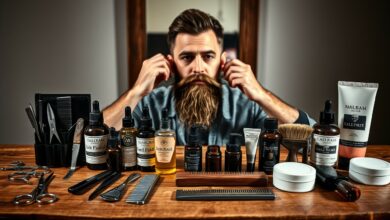Addressing Beard Dandruff

Just as you can get dry, flaky skin on your scalp, it is possible to get dandruff in your beard. The most common cause of beard dandruff is seborrheic dermatitis, which is caused by yeast growth on the skin. The symptoms include red, scaly, and flaky skin, along with persistent itching. The best way to treat this problem is by using dandruff shampoos containing active ingredients like ketoconazole, selenium sulfide, or pyrithione zinc. These shampoos should be applied to the dry skin and massaged in before rinsing. It is also important to avoid using petroleum jelly as it can worsen beard dandruff.
Also check out: The Importance of Regular Beard Trimming
Also check out: The Beginner’s Guide to Beard Grooming
Key Takeaways:
- Beard dandruff is caused by seborrheic dermatitis, a yeast growth on the skin.
- Using dandruff shampoos with active ingredients can effectively treat beard dandruff.
- Petroleum jelly should be avoided as it can worsen beard dandruff.
- Maintaining a healthy beard through proper grooming and lifestyle choices can help prevent beard dandruff.
Understanding the Causes of Beard Dandruff
Beard dandruff is a common problem that plagues many men, causing discomfort and embarrassment. To effectively address and treat beard dandruff, it is important to understand its underlying causes. The two main culprits behind beard dandruff are Malassezia, a fungus that thrives on oily skin, and dry skin.
Malassezia is a type of yeast that naturally occurs on the skin. However, when its growth becomes excessive and unbalanced, it leads to various skin issues, including beard dandruff. Individuals with oily skin are more prone to beard dandruff as the excess oil produced by their sebaceous glands provides an ideal environment for Malassezia to flourish. On the other hand, dry skin lacks the necessary moisture to keep the skin and beard healthy, leading to flaking and dandruff.
Another factor that contributes to beard dandruff is the accumulation of dead skin cells and oils. When these substances build up on the skin beneath the beard, they create an environment conducive to dandruff development. Therefore, proper cleansing and exfoliating routines are essential to prevent these build-ups and keep the skin beneath the beard clean and healthy.
Causes of Beard Dandruff
| Causes | Description |
|---|---|
| Malassezia | A fungus that thrives on oily skin and leads to excessive flaking and dandruff. |
| Oily Skin | Excessive oil production by sebaceous glands provides an ideal environment for Malassezia growth. |
| Dry Skin | Lack of moisture in the skin leads to flaking and dandruff. |
| Accumulation of Dead Skin Cells and Oils | Build-up of these substances on the skin beneath the beard contributes to dandruff development. |
In order to effectively combat beard dandruff, it is crucial to address the underlying causes. By understanding the role of Malassezia, oily skin, dry skin, and the accumulation of dead skin cells and oils, individuals can tailor their grooming routines to target these specific factors. With proper care and maintenance, it is possible to keep beard dandruff at bay and enjoy a healthy, flake-free beard.
Treating Beard Dandruff
To effectively treat beard dandruff, a combination of exfoliating, cleansing, and moisturizing is recommended. Exfoliating the skin under the beard with a soft-bristle brush can help remove dead skin cells and distribute oils. This process not only helps to alleviate beard dandruff but also promotes healthy beard growth. Regularly washing the beard with a shampoo designed for dandruff or a beard-specific cleanser is essential to keep the skin clean and prevent buildup. Look for products containing ingredients like ketoconazole, selenium sulfide, or pyrithione zinc, which have anti-fungal and anti-inflammatory properties that can help combat beard dandruff.
After washing, moisturizing the beard is crucial to prevent dryness and keep the skin hydrated. Using a beard oil or non-comedogenic oil can help nourish the skin and soften the beard, making it more manageable. Apply a few drops of beard oil to the palm of your hand, rub your hands together, and then gently massage the oil into the beard and skin. This will not only moisturize the skin but also promote healthy beard growth, reducing the likelihood of beard dandruff.
For more severe cases of beard dandruff, medicated shampoos can be used. These shampoos often contain active ingredients such as pyrithione zinc, coal tar, selenium sulfide, or tea tree oil, which can help eliminate the fungus causing beard dandruff. Follow the instructions on the product for the best results. It’s important to note that medicated shampoos may cause dryness or irritation, so it’s recommended to use a moisturizing beard oil or balm after washing to replenish moisture.
Recommended Products for Treating Beard Dandruff
| Product | Description |
|---|---|
| Dandruff Shampoo | A shampoo specifically formulated to treat dandruff and control fungal growth on the skin. |
| Beard Oil | An oil-based product that moisturizes the beard and helps prevent dryness and flakiness. |
| Medicated Shampoo | A shampoo containing active ingredients to target and eliminate the fungus causing beard dandruff. |
By incorporating exfoliating, cleansing, and moisturizing techniques into your beard care routine, you can effectively treat beard dandruff and maintain a healthy, flake-free beard. Remember to be consistent with your routine and choose products that cater to your specific needs. With proper care and attention, you can enjoy a dandruff-free beard that looks and feels great.
Natural Remedies for Beard Dandruff

When it comes to treating beard dandruff, there are natural remedies that can provide relief and help restore the health of your beard. These remedies can be used in conjunction with other grooming practices to effectively combat beard dandruff. Two popular natural remedies for beard dandruff are aloe vera gel and lemon juice.
Aloe Vera Gel
Aloe vera gel is well-known for its soothing and healing properties, making it a great option for treating beard dandruff. Applying a small amount of aloe vera gel to the affected area can help soothe the skin, reduce inflammation, and alleviate itchiness. The natural moisturizing effects of aloe vera can also help hydrate the skin, reducing dryness and flakiness.
Lemon Juice
Lemon juice, with its acidic properties, can act as a natural exfoliant to help remove dead skin cells and reduce flakes in the beard. However, it’s important to patch test lemon juice on the skin before use, as it can cause irritation for some individuals. If your skin tolerates lemon juice well, you can mix it with water and apply it to the affected area. Leave it on for a few minutes before rinsing off thoroughly.
While these natural remedies can be effective, it’s important to note that everyone’s skin is different, and what works for one person may not work for another. It’s always a good idea to consult with a dermatologist or skincare professional before trying any new remedies, especially if you have sensitive skin or any underlying skin conditions.
Aloe Vera Gel vs. Lemon Juice
| Remedy | Benefits | Precautions |
|---|---|---|
| Aloe Vera Gel | – Soothes and heals the skin – Reduces inflammation and itchiness – Provides natural moisturization | – Patch test for skin sensitivity – Avoid if allergic to aloe vera – Discontinue use if irritation occurs |
| Lemon Juice | – Acts as a natural exfoliant – Helps remove dead skin cells – Reduces flakes in the beard | – Patch test for skin sensitivity – Dilute with water before use – Rinse off thoroughly |
Remember, these natural remedies should be used in conjunction with a regular grooming routine that includes exfoliating, cleansing, and moisturizing. By maintaining a consistent routine and incorporating these natural remedies, you can effectively treat and prevent beard dandruff, promoting a healthier and more vibrant beard.
Preventing and Maintaining a Healthy Beard
When it comes to beard dandruff, prevention is key. By implementing a few simple strategies, you can keep your beard healthy and free from flakes. Here are some tips to help you maintain a healthy beard:
1. Trimming:
Regularly trimming your beard not only helps to keep it looking neat and well-groomed but also prevents the accumulation of dead skin cells and oils that can contribute to beard dandruff. Trimming also helps to promote healthy hair growth and can minimize the risk of ingrown hairs.
2. Prioritize Sleep:
Adequate sleep plays a crucial role in maintaining overall health, including the health of your beard. Lack of sleep can weaken the immune system and lead to dryness and flakiness in the skin. Aim to get 7-8 hours of quality sleep each night to support healthy skin and beard growth.
3. Balanced Diet:
What you eat can significantly impact the health of your beard. A diet rich in vitamins, minerals, and essential fatty acids can help promote strong and healthy hair growth. Include foods like lean proteins, fruits, vegetables, whole grains, and healthy fats in your diet to nourish your beard from the inside out.
4. Enjoy the Beard Benefits:
Embrace the benefits of having a beard. Not only does a beard provide a unique and attractive look, but it also offers some practical benefits. A beard acts as a natural barrier, protecting your skin from harmful UV rays and reducing the risk of sunburn and skin damage. Additionally, during colder months, a beard can help keep your face warm and protected from the elements.
By incorporating these tips into your beard care routine, you can prevent beard dandruff and maintain a healthy, well-groomed beard. Remember to trim regularly, prioritize sleep, eat a balanced diet, and enjoy the many benefits that come with having a beard.
Conclusion

Beard dandruff is a common issue that can be effectively treated through proper cleansing, moisturizing, and regular maintenance. By understanding the causes of beard dandruff and implementing a suitable routine, individuals can get rid of flakes and itchiness. The use of dandruff shampoos, natural remedies, and beard oils can provide relief and prevent the recurrence of beard dandruff. Additionally, maintaining a healthy lifestyle and following grooming tips can contribute to the overall health and appearance of the beard.
Beard Dandruff Treatment
To effectively treat beard dandruff, it is important to address the underlying causes. Regularly washing the beard with a dandruff shampoo containing active ingredients like ketoconazole, selenium sulfide, or pyrithione zinc can help control yeast growth and reduce dandruff. For individuals with more severe cases of beard dandruff, medicated shampoos may be necessary. In addition, exfoliating the skin under the beard, moisturizing with beard oil, and using natural remedies like aloe vera gel or lemon juice can provide soothing relief.
Healthy Beard Maintenance
Preventing beard dandruff and maintaining a healthy beard requires a consistent grooming routine and a healthy lifestyle. Regularly trimming the beard helps to keep it tamed and groomed. Getting enough sleep and following a balanced diet rich in nutrients can promote overall skin and beard health. It is also important to be aware of the benefits of having a beard, such as protection from UV rays and extra warmth during colder months. By taking care of the beard and following these tips, individuals can enjoy a healthy and dandruff-free beard.
FAQ
What causes beard dandruff?
Beard dandruff can be caused by a fungus called Malassezia, oily skin, dry skin, or the buildup of dead skin cells and oils.
How can I treat beard dandruff?
Treating beard dandruff involves exfoliating the skin, regularly cleansing the beard with dandruff shampoos or beard-specific cleansers, and moisturizing with beard oil or non-comedogenic oil. Some individuals may require medicated shampoos containing specific ingredients.
Are there natural remedies for beard dandruff?
Yes, natural remedies such as aloe vera gel and lemon juice can help soothe the skin and exfoliate dead skin cells. However, it’s important to patch test lemon juice before use.
How can I prevent beard dandruff and maintain a healthy beard?
Regular trimming, getting enough sleep, maintaining a healthy diet, and following a grooming routine can help prevent beard dandruff and maintain a healthy beard.
Also check out: Beard Shaping Techniques

